How to Teach Phonics Step by Step
Teaching phonics is essential to helping struggling readers learn how to read. But how do we know how to teach phonics? Here is an overview of how to teach phonics step by step to give your students a strong phonetic decoding foundation.
This phonics guide will help you give your students the tools and confidence they need to attack and decode any new word!
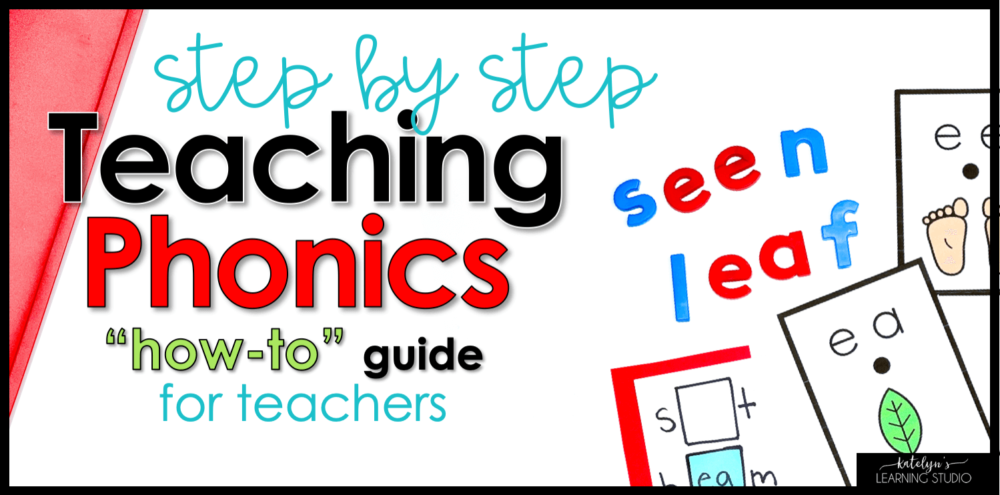
Definition for Phonics
- Phonics is connecting sounds to written letters and using those sounds to produce words. It is the decoding of words by looking at the sound each letter makes.
Basically, it is looking at the letters, saying the sounds they make, and figuring out what the word is based on those letters and sounds. Many people call this “sounding out words”. Phonics is one of the Big 5 areas of reading identified by the National Reading Panel (read more about the Big 5 reading areas here).
 Keep reading to download a FREE set of Phonics Flashcards + Sound Chart!
Keep reading to download a FREE set of Phonics Flashcards + Sound Chart!
Bonus Tip: Click here to get a FREE Reading Intervention Cheat Sheet!

Why is Phonics Instruction Important?
The phonics method of teaching reading has been in debate for decades but is finally being more and more accepted as essential in education. Phonics research shows that when students are directly taught phonics patterns and rules, especially struggling students, they are much more likely to read with fluency as they enter older grades. Learning to read with phonics gives students the tools they need to confidently approach, decode, and then orthographically map new words.
Teaching phonics makes students better decoders. When students can phonetically decode words, reading is less effortful. Thus, they are able to focus on the meaning of the text instead of decoding words. Follow these steps for how to teach phonics and you will empower your readers!
*Quick note: for a more thorough explanation of what phonics is, check out this blog post!
Benefits of Phonics Instruction
- Strengthens the concept of grapheme/phoneme relationship (the idea that sounds in words are represented by letters)
- Gives students tools to decode unfamiliar words
- Helps students feel more confident when approaching unfamiliar words
- Makes decoding multi-syllabic words easier to chunk by recognizing word parts and phonics patterns
- Can help strengthen phonemic awareness as students pay more attention to the sounds in words
- Improves word recognition
- Facilitates orthographic mapping as students focus on spelling and the letters that make up words
- Improves spelling and confidence in writing
Check out this post with 13 Phonics Strategies You Need to Try for more tips on how to teach phonics!
Now that we understand why phonics is important, let’s dive into how to teach phonics step by step!

STEP 1. How to Teach Phonics: Systematic and Explicit Phonics Instruction
If you are looking for how to teach phonics to struggling readers, this right here is it! Phonics instruction for our lower readers should follow a clear, systematic sequence and should be directly and explicitly taught. Learning to read passively or by exposure does not work for our struggling readers. They need structure and support!
Systematic phonics
Systematic phonics instruction means that skills are planned out and taught in a meaningful order that builds off of each other.
You start at the smallest word part (letters) and works up. Once students have strong letter knowledge, you move on to blending small single-syllable words, and then combining those syllables into longer multi-syllabic words.
In other programs, phonics sounds are spontaneously taught as they are encountered in natural reading. Our lower readers, however, need phonics sounds to be taught in an organized, sequential way. Their brains have a hard time organizing and storing phonics knowledge, so organizing and presenting it in an organized manner is helpful to them.
Systematic phonics instruction examples can be seen below in the “Phonics Skills” section. There, I go over how to teach phonics in the best order.
Explicit Phonics Instruction
Explicit phonics instruction means the teacher clearly shows the letter(s) and says the sound that they make to the students. There is no guessing or discovery, but there is complete clarity and direct phonics knowledge being taught.
To see an easy “I do, We do, You do” explicit lesson plan, read the last tip in my post 11 Reading Intervention Strategies that Work.
That’s how to teach phonics to struggling readers: nothing fancy, but everything simple, organized, and clear.
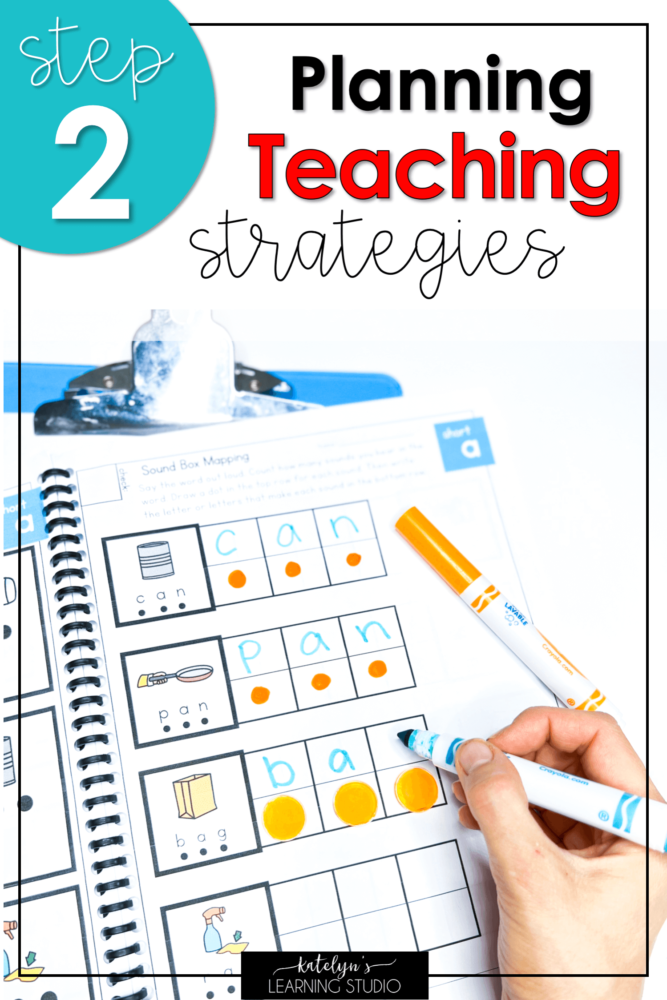
STEP 2. How to Teach Phonics: Phonics teaching strategies
The best phonics teaching strategies always relate graphemes (letters) to phonemes (sounds)–I explain why in my 11 Easy Word Mapping Activities post. Here are some examples of phonics activities you can use to do this:
Traditional Phonics Teaching Methods (still good)
- Show the letter (grapheme) and say the sound that goes with it (phoneme)
- Say the sound and have students identify the letter(s)
- Show the letters and have students practice saying the sound
- Have students practice writing words with the specific phonics pattern
Teaching Phonics Activities with the Science of Reading (takes it even deeper)
- Say a word and segment it into its sounds; then show the written word and have students match up which letters go with which sounds they said
- Say a word and count how many sounds it has; place that many blanks on a paper/whiteboard; have students fill in the letters that go with each “sound blank”
- Show a written word; have students write a dot for each sound under the letter(s) that make that sound
- Have students read a word, spell it out loud, then try to spell it out loud with their eyes closed and check afterward if they spelled it right; finally, have them write it on paper by memory and then check if they spelled it correctly
For more phonics instruction strategies, read this blog post! It has some great phonics activities and tips.
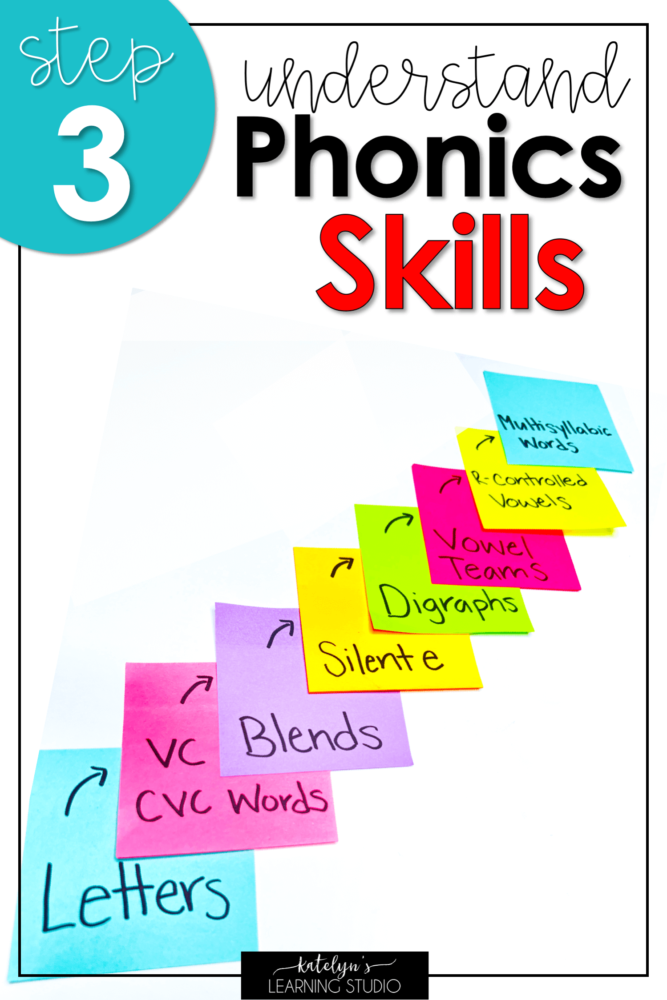
STEP 3. How to Teach Phonics: Phonics Skills
The first step in how to teach phonics is to understand how phonics skills are learned yourself!
Phonics skills are developed in a specific order (remember the systematic instruction we talked about above?). The skills build off of each other, so when you follow the correct sequence, learning new phonics patterns comes more easily.
Below (steps 4-7) is a suggested sequence on how to teach phonics step by step for beginners. It follows a systematic scope and sequence, starting with basic phonics and working up.
You can also find a great visual reference for phonics skills in this FREE reading skills step ladder.
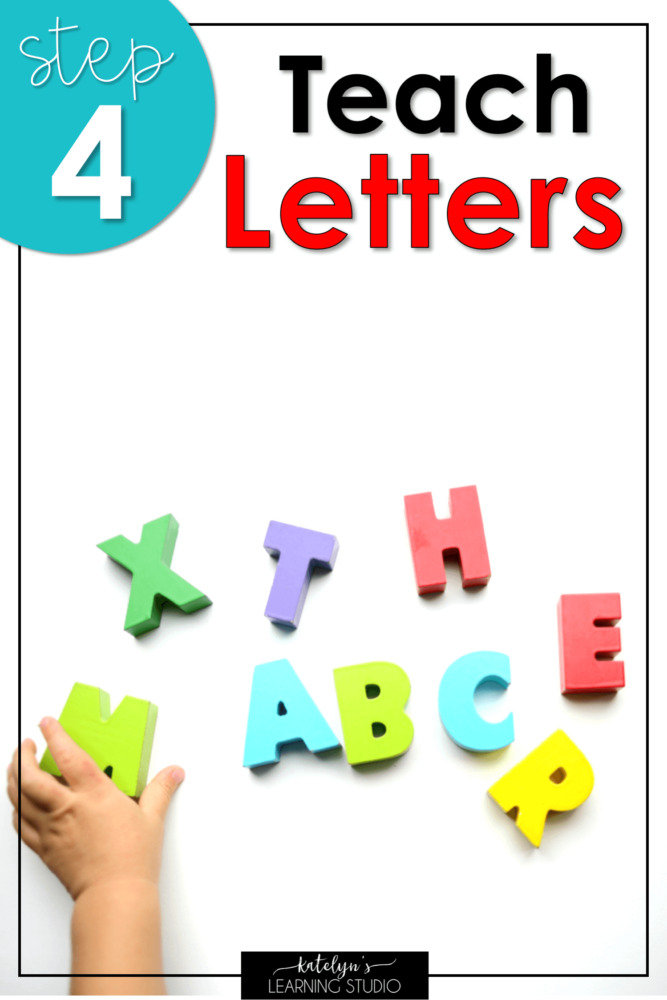
STEP 4. How to Teach Phonics: Order to Teach Letters
How to teach phonics for beginners starts with letters. You can teach letter sounds at the same time you teach letter names. There is an order of teaching phonics letters and sounds that helps students learn the letters most efficiently.
The best order to teach letters:
- Start with letters whose names begin with their own sounds (ex: B, D, J, K, T, etc.).
- Next, you want to teach letters whose names have their sound somewhere besides the beginning (F, L, M, N, R, S, etc.).
- Then you teach letters that have multiple sounds (A, E, I, O, U, C, G, etc.) plus Q.
- Last, you can teach the letters that do not have their sounds anywhere in their name (H, W, Y)
Teaching Vowels
I want to put an emphasis on teaching vowel sounds. Learning vowel sounds is crucial to reading, as every single syllable in every word has a vowel sound and most syllables contain a vowel. We want students to know the short vowel sounds AND long vowel sounds, and to know them very well.
For some no-prep, quick and easy letter activities, check out my Letter Skills Intervention Binder!

STEP 5. How to Teach Phonics: Reading Words
The next step in how to teach phonics is the exciting part–reading words! Now that the students have a strong letter knowledge base, they are ready for word reading. They get to blend the sounds they read from the letters into actual words. You will want to practice both real and nonsense words for each of these phonics patterns. If you’d like done-for-you CVC word intervention, check out my CVC Words Intervention Binder or my Science of Reading CVC Practice Folders.
a. v-c words
Start with v-c words. What are v-c words? The smallest and most simple form of a word we can blend. v-c words start with a vowel and end with a consonant, and always have the short vowel sound.
- For example: at, in, up, on, etc.
b. c-v-c words
What are c-v-c words? Take the v-c words we just talked about, and stick a consonant at the beginning. So it’s consonant vowel consonant. Again, these are simple words to decode as they are straightforward and follow all of the basic “phonics rules.” The vowel will always say its short vowel sound.
- Examples of cvc words include: cat, fit, bed, mud, hog, etc.
How to Teach Blending cvc Words
The initial learning curve of blending words together can be tricky for kids. A way to help bridge the gap for this skill is to start with words that have continuous consonant sounds (/m/, /s/, /n/, /l/, etc.).
Instead of having students stop after each sound, have them drag the sounds out and “slur” them together. This is called connected phonation, as opposed to segmented phonation. Starting with connected phonation builds blending skills and students are better able to read words with stop sounds (cat, big, tub, etc.) later on, compared to students who were trained from the start with segmented phonation.
I have a blog post all about how to blend cvc words that gives you more in-depth ideas for teaching the c-v-c patterns.

STEP 6. How to Teach Phonics Patterns
Next comes phonics patterns! Now that students are able to blend sounds together to make words, they can apply that skill to words with phonics patterns. I have a Phonics Intervention Binder with interactive activities that cover EACH phonics pattern you can check out here, plus you can download these FREE phonics flashcards and a phonics chart (pictured above) to help you!

Click here to download these FREE phonics flashcards and a sound chart!
Here are the steps for how to teach phonics patterns and sounds in sequential order!
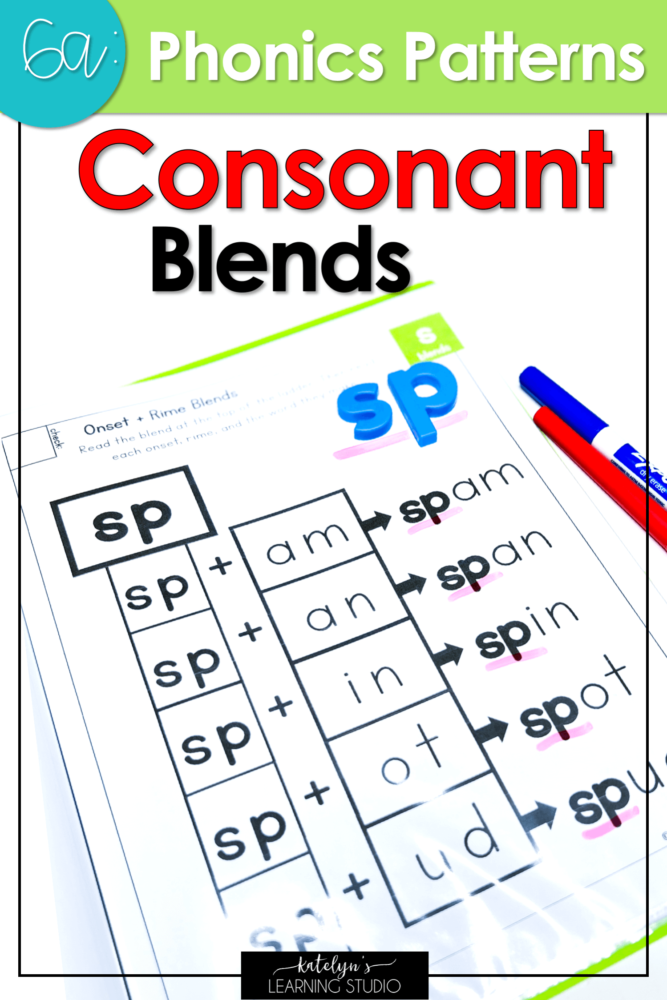
a. Consonant Blends
Words with 2 or more consonants together at the beginning of the word (or syllable), end of the word (or syllable), or both. These words are called CCVC, CVCC, or CCVCC words. Sometimes they are also called consonant clusters.
Consonant Cluster Examples:
- Beginning blends: /pl/ as in plan, /cr/ as in crab, /sn/ as in snip
- Ending blends: /nt/ as in bent, /lk/ as in milk, /nd/ as in hand
- Beginning and ending blends: /pl/ and /nt/ as in plant, /tr/ and /mp/ as in tramp
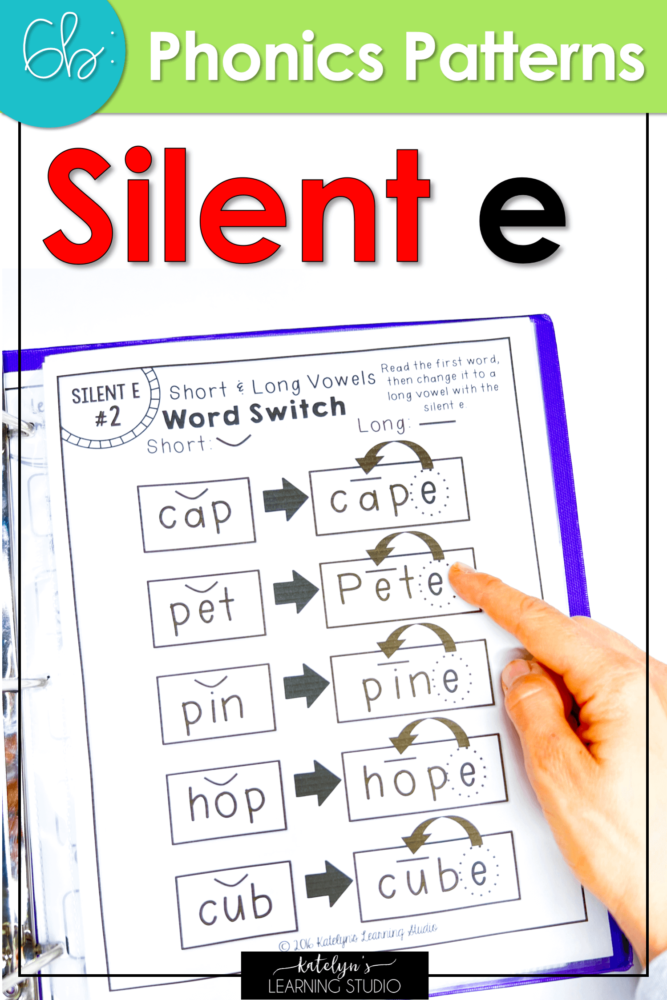
b. Words with Silent e
Words that have a cvc or vc pattern, but then an “e” added onto the end (CVCe or VCe). The vowels in these words make their long sound, and the “e” is silent. Sometimes these words are called “bossy e” words.
Silent e Words List:
- a_e words: cane, gate, same, tape, made
- e_e words: Pete, meme, these, eve, theme
- i_e words: hike, lime, side, kite, dive
- o_e words: rope, mode, home, nose, vote
- u_e words: tube, fume, mute, tune, cute
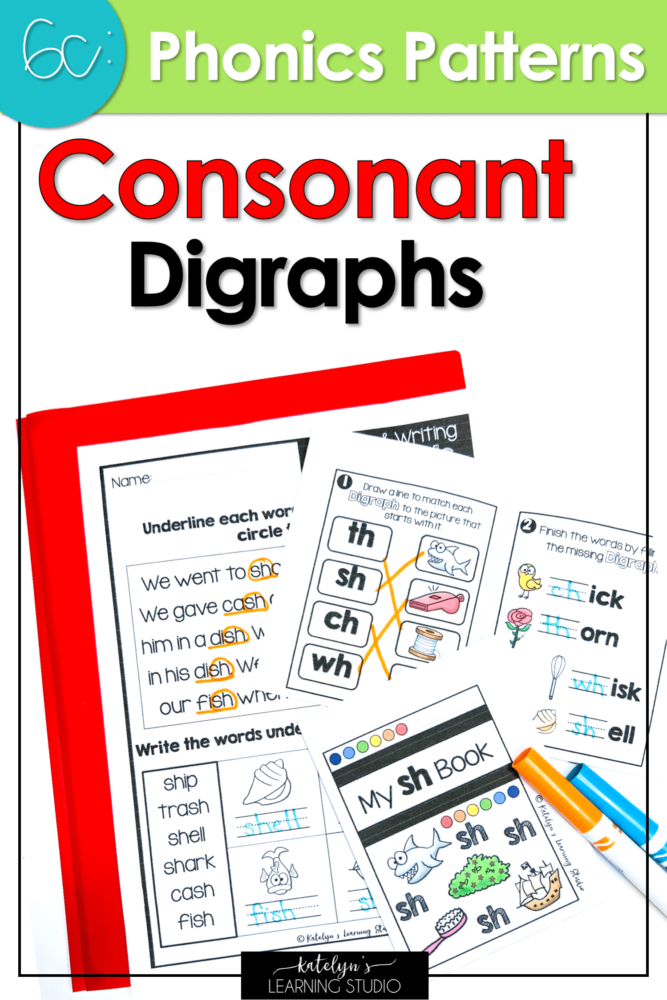
c. Consonant Digraphs
Digraphs are when two letters join together and make one sound. So a consonant digraph is two consonants that make one sound. The main consonant digraphs we teach are th, sh, ch (along with tch at the end of some words), wh, and ph in the upper grades.
Consonant Digraph Words List:
- th words: thin, thick, this, moth, bath, with
- sh words: ship, shut, shop, wish, lash, mush
- ch words: chop, chin, chug, lunch, bench, much
- tch words: match, pitch, witch, patch
- wh words: whim, whisk, whip, when, whiff, whale
- ph words: phone, phonics, photo, dolphin, graph

d. Vowel Digraphs (vowel teams)
Vowel digraphs, or vowel teams, are two vowels that come together and make one sound. The vowel digraphs are ai, ay, ea, ee, oa, oo, oi, oy, and au. Ow and aw are also often grouped with vowel digrpahs because they make similar sounds. Ui and ew are two more vowel digraphs typically introduced after the others.
“When two vowels go a walking, the first one does the talking” is a common rhyme to help remember what sound vowel digraphs make, but be sure to teach them it only works for some of the vowel digraphs.
*A note to remember is that some of the vowel digraphs have multiple sounds. “Ow” can make the long /O/ sound as in snow, and the diphtohng sound /ow/ as in cow. “Oo” can also make the long sound /oo/ as in moon, and the short /u/ soundas in book.
**Another tip to remember is most vowel teams that end in y or w usually come at the end of a word (ay, ow, oy, aw, ew). –however, this is not always the case!
Words with vowel digraphs examples:
- ai words: rain, wait, main, bait, stain, paint
- ay words: pay, may, way, lay, stay, play
- ea words: seat, lean, hear, meat, seal, lead
- ee words: feet, seen, need, teen, feel, deep
- oa words: boat, toad, loaf, soap, loan, foam
- ow words /O/: snow, tow, row, bow, low, glow
- ow words /ow/: cow, plow, bow, sow, brow, vow
- ou words: out, loud, hour, mouth, sour, cloud
- oo words /oo/: moon, food, root, boot, snoop, loom
- oo words /u/: look, book, took, wood, foot, nook
- oi words: oil, soil, boil, coin, foil, noise
- oy words: toy, coy, boy, ploy, soy
- au words: faun, daunt, haul, vault, haunt, launch
- aw words: lawn, yawn, paw, claw, law, jaw
- ui words: fruit, suit, juice, cruise, bruise
- ew words: flew, crew, grew, blew, few, chew
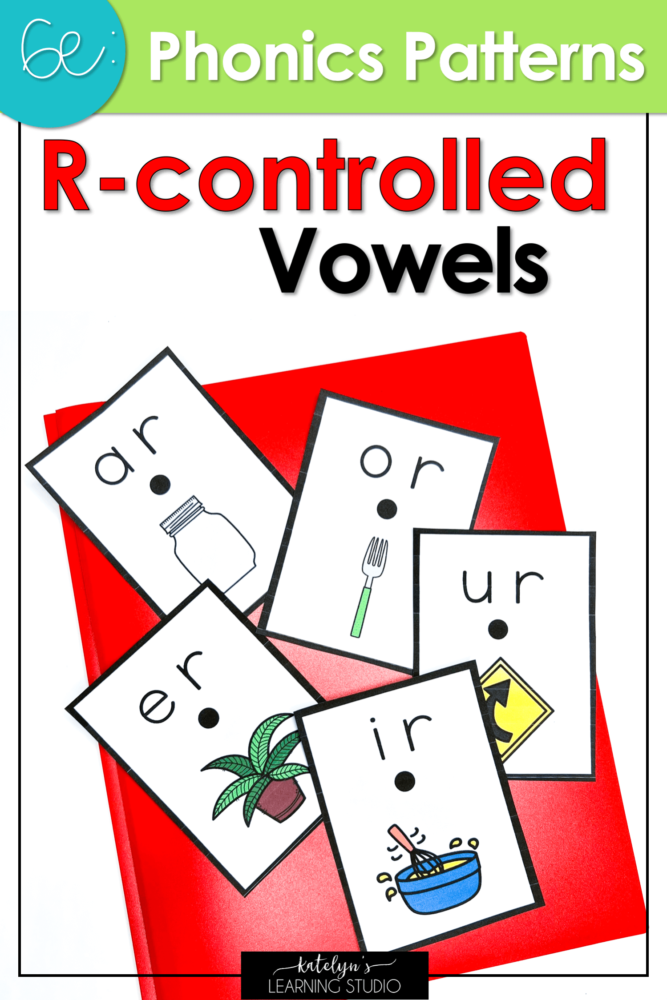
e. R Controlled Vowels
When an r comes directly after a vowel, the r changes the sound the vowel makes. Words with this pattern are called r-controlled vowel words. It’s important to explicitly teach these words, because the vowels do not make the normal short or long sound. To teach r controlled vowels, teach the ar, or, ir, er, and ur patterns as a unit–like when teaching digraphs. Show the two letters, and say the sound they make together. I like to teach ir, er, and ur at the same time because they all make the same sound.
R controlled vowel words:
- ar words: car, far, star, barn, yard, harm
- or words: for, born, sort, fort, cord, thorn
- ir words: bird, stir, firm, shirt, dirt, first
- er words: her, term, herd, fern, perm, stern
- ur words: fur, curl, turn, surf, hurt, slurp
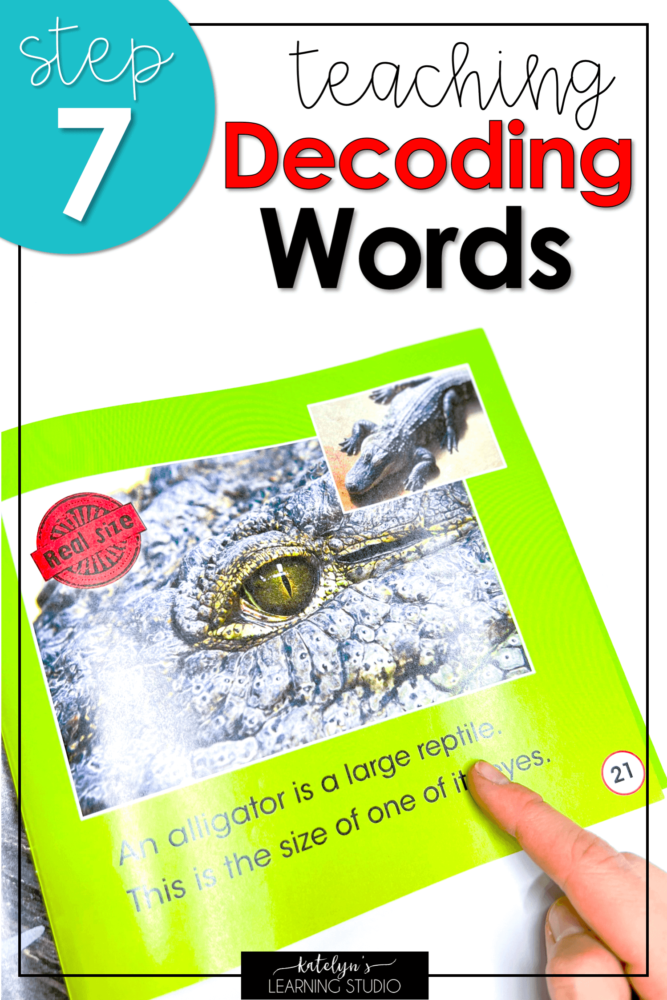
STEP 7. How to Teach Phonics: Decoding Words
Here is the step by step path students follow to learn how to decode words.
Phonics Decoding Steps:
- Learn letter sounds
- Blend simples words (v-c words, c-v-c words, and consonant blends words)
- Learn phonics patterns
- Blend simple 1-syllable words with phonics patterns
- Decode multisyllabic words
Notice there is a pattern in the steps. You start by giving students the tools they need to be successful, and then you teach them how to apply those tools to reading words.
You teach the letter sounds, then you use those sounds to decode simple words. Then you teach phonics sounds, and then decode words with those phonics sounds. Those first 4 steps were actually teaching students how to read syllables. Now that they are able to read simple regularly spelled syllables and syllables with phonics patterns, they can apply that knowledge to decoding multisyllabic words (which are made up of all of the simple words they have been learning).
a. How to Teach Phonics: Decoding Multisyllabic Words
As I mentioned above, multi syllabic words are made up of multiple smaller words, or syllables. Students have been practicing reading those simple c-v-c words and words with phonics patterns. They are now equipped to conquer longer words made up of those smaller words. Multi syllabic words can be intimidating and students can get overwhelmed and shut down. However, they gain so much confidence when they realize that these longer words are made up of words they already know.
Tips for decoding multisyllabic words:
- Start with common word endings, like “-ed, -ing, -er, -est”. These endings are found with a lot of simple words that are easy to read.
- Next work with compound words. These are made up of 2 simple words they likely already recognize and are easy to break into those words.
- Next, you can move on to 2 syllable words, then 3 syllable words, and so on. These words might have syllables that are not real words on their own but follow the c-v-c or phonics pattern rules they’ve already learned.
- To read even more words quickly and easily, you can teach them prefixes (pre-, un-, re-, dis-, etc.) and even more suffixes (-tion, -ous, -al, -ness, etc.)
- Teach the 6 syllable types: closed, open, silent e, vowel team, r-controlled, and final -le (this strategy is amazingly effective and you can find all you need to teach it in this Multisyllabic Words Intervention Binder!)
*For more tips on teaching multisyllabic words, check out this awesome blog post: 7 Best Ways to Teach Multisyllabic Words to Struggling Readers
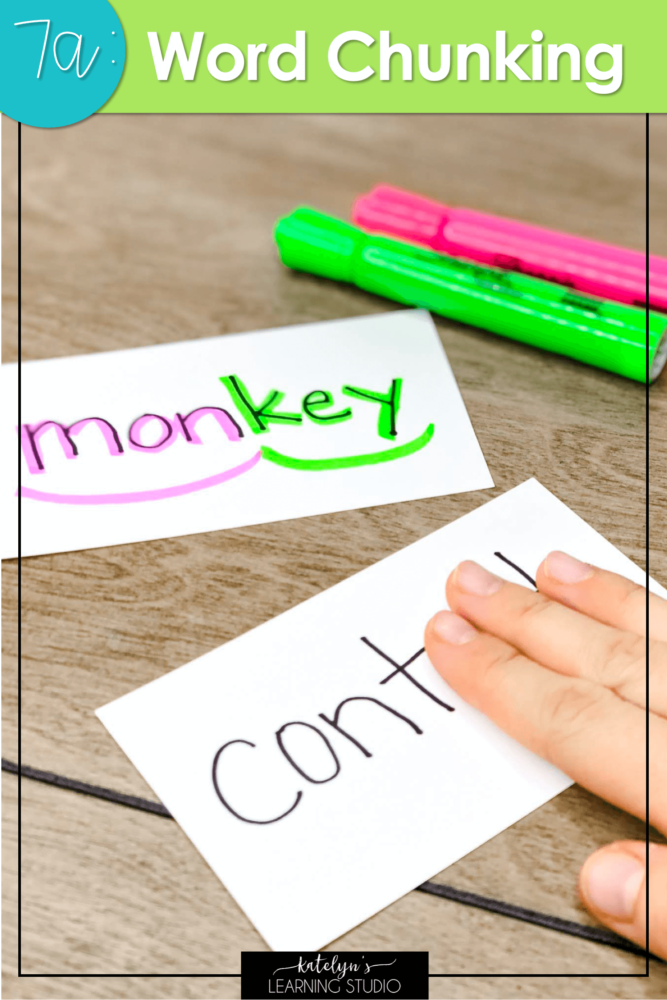
b. How to Teach Phonics by Chunking Words
In order to not get overwhelmed, it is crucial for students to realize that large words are made up of smaller word parts that are actually pretty easy to read. Chunking words, or separating them into smaller parts, is a great way for kids to approach big words.
Activities to help students chunk words:
- Hand Cover: cover most of the word with your hand, leaving the first part visible. Read that first part, then slide your hand over to reveal another part. Keep sliding and reading until the whole word is read.
- Highlighters: highlight each word “chunk” with a different color
- Lines: Draw lines in between each word part with a pencil or marker
- Chunking “Swoops”: Draw a swoop (upward curve) under each word chunk. Have students drag their finger across the swoop as they read the chunk above it.
- Letter Tiles: Spell the whole word in letter tiles. Then scoot the letters so that they are in groups of “chunks” to read one at a time. Then scoot them all together again for students to read the whole word.
Pro-Tip: Phonics Intervention Binder!
For no-prep, already done-for-you phonics activities, check out my phonics intervention binder! It can help you target the phonics skills your student needs and track progress on those essential skills.
Freebie Alert: Reading Intervention Cheatsheet
For specific ways to identify students who struggle with phonics, as well as activity ideas to help them and more tips for how to teach phonics, download my FREE Reading Intervention Cheat Sheet!

Hopefully, now you have a better idea of how to teach phonics step by step. Teaching phonics is an important part of an effective reading intervention program, especially when it is explicit and systematic. Phonics instruction is most effective when it is taught alongside phonemic awareness (read more about mapping graphemes to phonemes here), and when you start simple and work up to more challenging phonics skills. The Science of Reading tells us that teaching phonics is a huge part of what gives struggling readers the chance to catch up. When you learn how to teach phonics the correct way, it will make a world of difference for your struggling readers!
